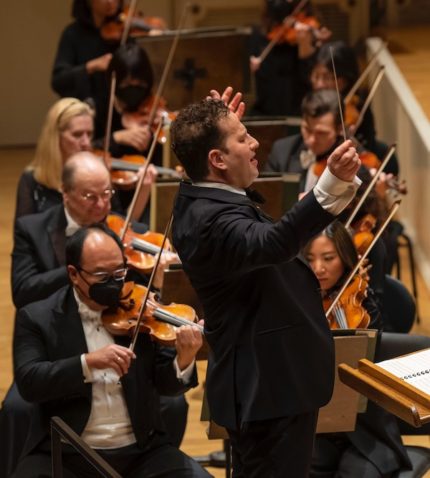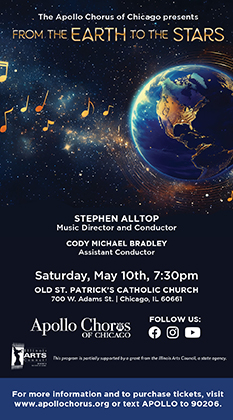CSO wraps the year with festive program of French showpieces

Winter blew into Chicago Thursday with a heavy early-evening snowfall that bedeviled rush-hour drivers. Yet the snow provided apt scenic splendor along with the wreaths festooning Symphony Center to set the mood for the Chicago Symphony Orchestra’s final program of 2022, as Nikolaj Szeps-Znaider led a program of French showpieces.
The towering Danish musician first came to fame two decades ago as a greatly talented and charismatic violinist. As shown in previous CSO stands, Szeps-Znaider has made a graceful transition to the podium, and he directed the evening’s populist works with a confident hand, incisive focus, and sure pacing.
The CSO gave the U.S. premiere of The Sorcerer’s Apprentice in 1899 under founder Theodore Thomas. Even before Disney’s Fantasia came out in 1940 and made Paul Dukas’ orchestral scherzo inescapable for decades, it had already become a concert staple in Chicago and was performed nearly every season.
With the passage of time and more judiciously separated revivals, Sorcerer’s Apprentice is now less immediately identified with Mickey Mouse—brilliantly realized as the famous animated version was—and one can appreciate Dukas’ work for the orchestral gem it is. NSZ led a vital, finely textured performance that brought out Dukas’ artful scoring, making the humor of the piece surprisingly fresh and effective. The CSO bassoons morphed into a characterful galumphing band of anthropomorphic broomsticks.
Francis Poulenc’s Concerto for Organ, Strings and Timpani is arguably the finest of 20th century concertante works for organ and orchestra. With its multitude of colors and timbral possibilities—Mozart called it “the King of instruments”—the organ is practically an orchestra all by itself. Indeed, the best known organ concertos not by Handel are solo works for the instrument alone. Charles-Marie Widor wrote ten solo concertos that he called “organ symphonies.”
As indicated by its title, Poulenc’s 1938 concerto dispenses with winds and brass entirely. Cast in a single unbroken movement, the concerto freely mixes tempos and styles in seven continuous sections, segueing from neo-Baroque chromaticism to lush romantic harmonies, elegant Gallic lyricism, and back again.

Cameron Carpenter was the evening’s soloist. From his flamboyant press photos over the last decade, one was expecting a theatrical stage persona for the organist’s CSO debut. Instead, clad simply in casual black with a diamond earring and closely cropped hair, the Titusville, Pennsylvania native suggested a vaguely resentful New Wave rocker. With an almost diffident stage demeanor, Carpenter was all business Thursday night.
Though he is known for his free-style interpretation of solo works, in this concerto Carpenter kept the focus on Poulenc’s music, putting across the Baroque burning embers, floating the cool lyricism and trading rapid passages with the CSO strings under Szeps-Znaider’s alert direction.
While there are no big breakout cadenzas in this tightly woven work, Carpenter managed to put some subtle backspin on the solo part performing on Orchestra Hall’s Casavant-Frère organ—an ad-libbed flicker here an unexpected registration there—without ever upstaging the score or his colleagues. NSZ handled the tricky coordination of solo organ, strings and timpani with ease and professional skill.
The evening concluded with Camille Saint-Saëns’ Symphony No. 3.
When asked to place himself in the pantheon of great composers, Saint-Saëns is reported to have replied “In the first rank of the second-rate composers.” The composer was unfair to himself in his self-effacing reply, as he wrote brilliantly and prolifically in all genres.
Along with his opera, Samson et Daila, Saint-Saëns’s “Organ Symphony” is his most popular work, and for good reason. The symphony is masterfully crafted, sumptuous in melody, and audaciously scored—four-hand piano cascades appear as well as the spotlit organ. The composer deploys the latter effectively yet with restraint, saving its first appearance to open the Poco adagio and holding its full power in reserve for the exhilarating finale.
NSZ led the vast deployed forces in a trim and stylish account that felt idiomatically French—nothing was exaggerated for effect, yet there was ample punch and excitement without playing to the gallery. The strings’ soaring theme in the Poco adagio was refined and luxuriant in tone yet kept in scale.
The pizzicato variant near the end of that section was somewhat covered but that was the only balancing issue. NSZ attentively held the vast forces together, allowing each color and effect to make impact, and building steadily to the closing bars, which were thrilling and resplendent. Despite the symphony’s subtitle, the organ is part of the ensemble here and Cameron did all that was required, providing subtle backing hues, floor-shaking pedal points and sonic blasts as needed.
The program will be repeated 1:30 p.m. Friday, 8 p.m. Saturday and 3 p.m. Sunday. cso.org
Posted in Performances


Posted Dec 16, 2022 at 2:23 pm by niloiv
I first saw Mr Carpenter in concert around 5-6 years ago. Back then he was exactly what you imagine from looking at his press photos – with the Mohawk hair, nearly overpowering the orchestra every time he joined, jumping on/off the console on ovation, and giving generous and flamboyant encores.
Maybe time mellowed his personality and art. I found his playing yesterday gelled quite well with the orchestra
Posted Dec 16, 2022 at 3:44 pm by Frank
The ‘Organ’ symphony is one that the music is felt with ears and a deep rumbling through your seat.
Well done.
Posted Dec 16, 2022 at 5:30 pm by Thomas Trimborn
This concert was indeed a treat, rich in all the tone colors that can come from such a marvelous orchestra. As always the brass, and woodwinds (especially the bassons) were stellar. But the strings were exceptionally lush in the poco adagio of the organ symphony.
Szeps-Znaider’s interpretations throughout the program were elegant and clear. Carpenter was not only a superb soloist, but a wonderful ensemble member. In the organ symphony he certainly provided not only the sonic splendor but perfect subtle support. Bravo to all!